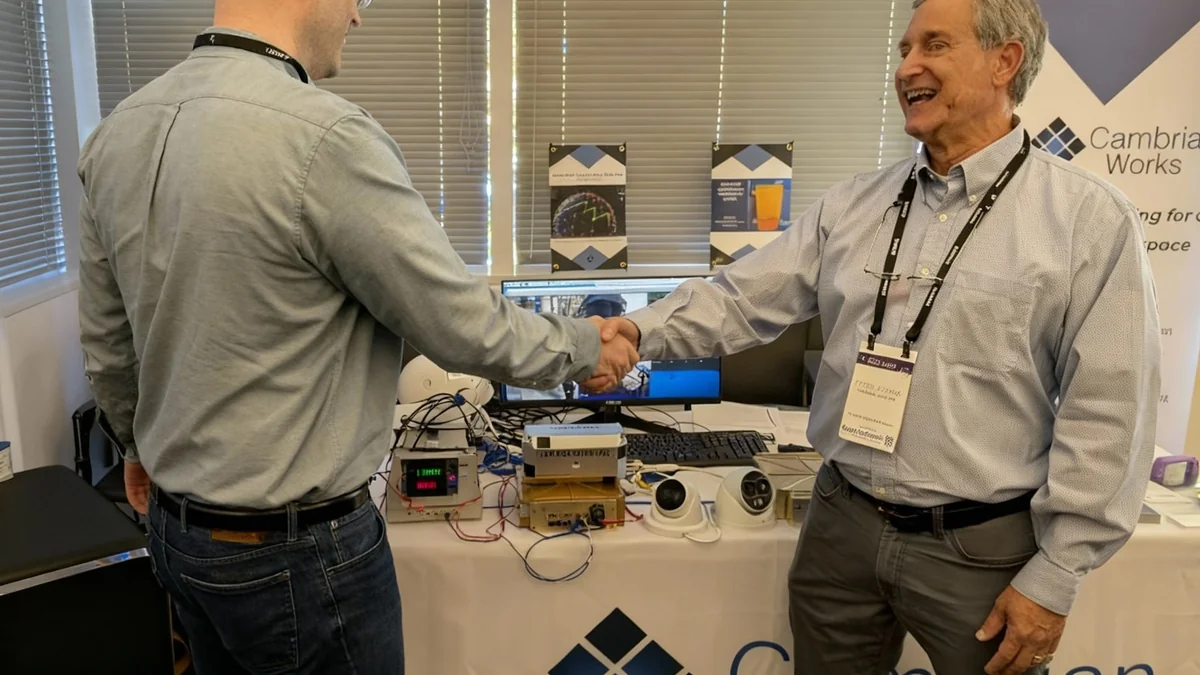In a move set to advance in-space connectivity, Cambrian Works and Aptos Orbital have announced a partnership to integrate their respective networking technologies. The collaboration will combine Cambrian Works' GigRouter with Aptos Orbital's communication terminal, aiming to create a unified system that allows diverse satellite constellations to communicate seamlessly in orbit.
This initiative addresses a growing need for reliable, real-time data transfer between satellites and from space to the cloud. By creating an interoperable network, the partnership seeks to provide satellite operators, including those with older spacecraft, with new options for data relay and mission management.
Key Takeaways
- Cambrian Works and Aptos Orbital are partnering to integrate their space networking technologies.
- The goal is to enable autonomous, multi-constellation networking in space.
- The system will combine Cambrian Works' GigRouter with the Aptos Orbital Terminal.
- This will allow satellites to connect to an existing relay network for real-time data transfer and tasking.
- The collaboration aims to enhance the capabilities of both new and legacy satellite systems.
A New Era for Satellite Communication
The partnership brings together two distinct but complementary technologies. Cambrian Works provides the GigRouter, a device that functions as a powerful space-based router. It is designed for complex satellite networking and includes edge-computing capabilities, allowing data to be processed directly in orbit.
Aptos Orbital contributes its flight-proven RF Terminal, which connects spacecraft to its operational satellite relay network. This network enables continuous connectivity, bypassing the traditional reliance on ground stations for data transmission. By linking these two systems, the companies intend to create a robust and flexible communication backbone in space.
The combined solution will offer satellite operators a trusted secondary network for data relay. This is particularly important for missions that generate time-sensitive information, such as Earth observation or weather monitoring, where immediate data dissemination is critical.
Technology at a Glance
- Cambrian Works GigRouter: An advanced space router with orbit-aware mesh networking and edge-computing functions.
- Aptos Orbital Terminal: A flight-proven RF terminal that provides constant connection to the Aptos satellite network for space-to-cloud integration.
Enhancing Interoperability in Space
One of the primary goals of this collaboration is to foster an interoperable "Space Internet." Currently, many satellite constellations operate in closed loops, unable to easily communicate with spacecraft from other operators. This partnership aims to break down those barriers.
Victor Aguero, CEO of Cambrian Works, highlighted the potential to modernize existing assets in orbit.
"This milestone demonstrates the opportunity to bring even legacy systems into an interoperable Space Internet future where spacecraft will have the ability to tap into the Aptos space network to complete their mission goals, with autonomous networking in space."
This capability means that older satellites, not originally designed for such advanced networking, could be retrofitted or tasked to use the new system. This extends the useful life of existing infrastructure and expands the overall capacity of the in-space communication network.
The Power of Mesh Networking
The technology relies on a decentralized, mesh-networking architecture, similar to the terrestrial internet. Instead of a direct-to-ground model, satellites can relay data to one another until it reaches its destination. This creates a more resilient system that is less vulnerable to single points of failure, such as a ground station being out of range or offline.
Aptos Orbital's founder, Yonatan Winetraub, emphasized the user-friendly aspect of their approach.
"Our RF-based intersatellite link will be compatible with an even wider range of spacecraft thanks to this partnership. We look forward to seamless deployments of our combined system as we create the easiest to use space network."
The focus on ease of use is critical for attracting a wide range of customers, from large government agencies to smaller commercial satellite operators who may not have extensive networking expertise.
The Growing Demand for In-Space Infrastructure
This partnership is part of a broader industry trend focused on building robust infrastructure directly in orbit. Other recent initiatives include plans for in-space data centers on the International Space Station and contracts to service and extend the lives of existing satellites. The ability to compute, process, and relay data in space reduces latency and reliance on ground infrastructure, paving the way for a more autonomous and efficient space economy.
Next Steps and Future Implications
Over the coming months, the two companies will focus on the technical integration of the GigRouter and the Aptos Terminal. The plan is to conduct demonstrations that showcase the end-to-end capabilities of the combined system, including real-time satellite tasking and rapid data dissemination.
These demonstrations will be crucial for potential customers seeking multiple, redundant options for managing their space assets. In an increasingly congested and contested space environment, having diverse communication pathways is a significant strategic advantage.
The long-term vision is to create a foundational layer for the burgeoning space economy. As more activities—from manufacturing and servicing to scientific research—move into orbit, the need for seamless, high-speed communication will only grow. This collaboration represents a key step toward building the reliable infrastructure required to support that future.
By enabling a machine-to-machine economy in space, Cambrian Works and Aptos Orbital are positioning themselves at the forefront of a new wave of innovation, where autonomous robotic systems can collaborate and share information without constant human intervention from the ground.





